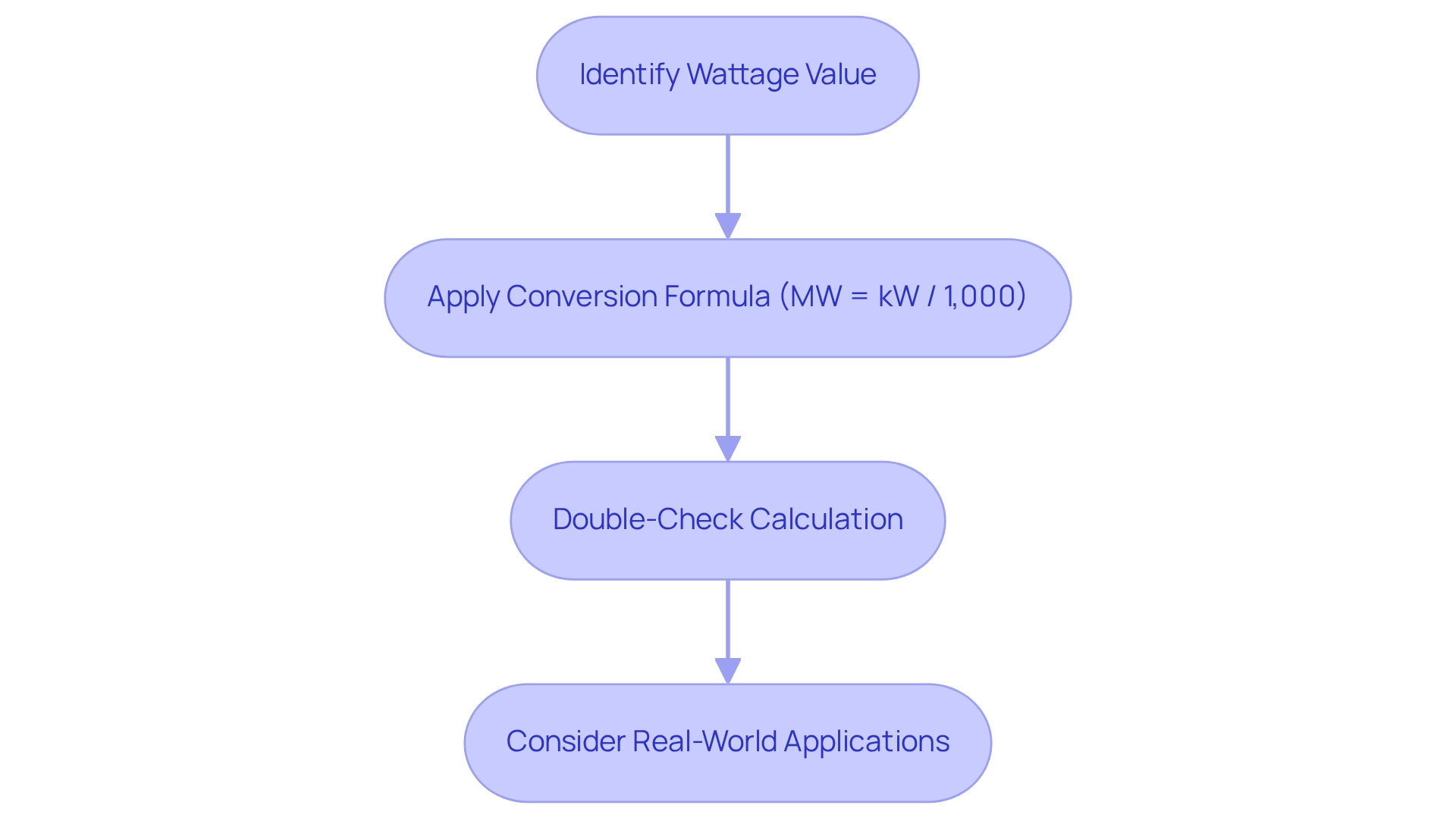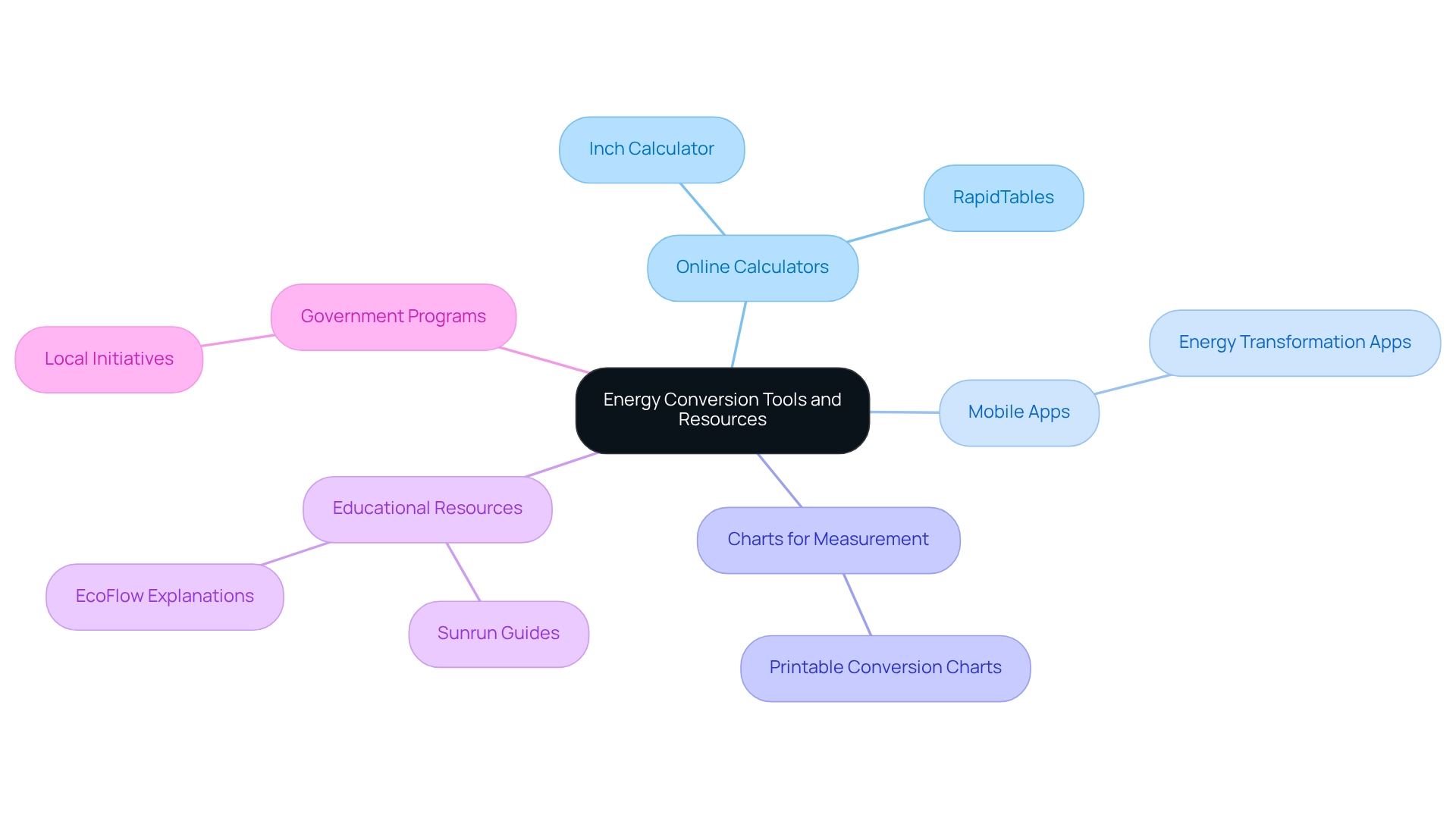Overview
This article addresses a common concern for many homeowners: the rising energy bills. Understanding how to convert kilowatts (kW) to megawatts (MW) is not just a technical necessity; it’s a step towards gaining control over your energy consumption. In the context of renewable energy systems, this conversion holds significant importance. By grasping these power units, you can make informed decisions regarding solar power investments.
We understand that navigating the world of energy can feel overwhelming. That’s why this article provides a step-by-step guide for the conversion process, making it accessible for everyone. As interest in renewable energy solutions continues to rise, it’s comforting to know that you are not alone in seeking sustainable options that can lead to energy independence.
Let’s reflect on how these changes can positively impact your life. By investing in solar energy, you not only contribute to a healthier planet but also take a significant step towards reducing your reliance on traditional energy sources. Together, we can explore the benefits of making this transition.
In conclusion, we invite you to take action. Understanding kilowatts and megawatts is just the beginning. With the right knowledge and support, you can confidently embark on your journey toward sustainable energy solutions. Remember, we are here to guide you every step of the way.
Introduction
In the ever-evolving landscape of renewable energy, we understand that concerns about rising energy bills can weigh heavily on homeowners. That’s why understanding the nuances of power measurement is more crucial than ever. Kilowatts (kW) and megawatts (MW) are foundational units in assessing energy production, especially within solar energy systems. As more homeowners turn to solar solutions, grasping these concepts not only aids in making informed decisions but also enhances the ability to optimize energy consumption.
This article delves into the significance of kilowatts and megawatts, providing a comprehensive guide on:
- Converting between the two
- Utilizing available tools
- Troubleshooting common conversion issues
Ultimately, it empowers you to navigate the complexities of energy management in your pursuit of sustainability. Together, we can work towards a more energy-independent future.
Understand Kilowatts and Megawatts
Kilowatts (kW) and megawatts (MW) are essential units of power measurement in the world of electricity, and we know that the concept of kilowatt megawatt conversion can feel overwhelming. The kilowatt megawatt conversion indicates that a kilowatt represents 1,000 watts, while a megawatt equals 1,000 kilowatts or 1 million watts. This understanding is particularly important for homeowners considering photovoltaic systems, where the kilowatt megawatt conversion is essential since power output is often measured in kW or MW. For instance, a typical residential panel system usually generates between 5 kW and 10 kW, while larger installations, like energy farms, can produce several megawatts of power, which demonstrates the concept of kilowatt megawatt conversion.
We know that evaluating your power usage and generation is crucial for managing energy bills effectively. As the industry evolves, this knowledge becomes increasingly significant. Recent surveys indicate that:
- 78% of installers anticipate heightened sales in 2025, reflecting a growing interest in renewable power solutions.
- California’s diverse incentive programs and financing options make it easier for homeowners to invest in renewable energy systems, enhancing the appeal of understanding these power measurements.
Experts emphasize that understanding kilowatt megawatt conversion is vital for maximizing the benefits of renewable energy. By recognizing the kilowatt megawatt conversion and how these units relate to their residential photovoltaic panel output, homeowners can make informed choices about their power needs and sustainability goals. Moreover, selecting the right heating system involves understanding local climate, household requirements, and budget, ensuring that the chosen system not only meets power demands but also contributes to long-term cost savings and environmental benefits. As the solar market stabilizes in the post-pandemic era, understanding kilowatt megawatt conversion will be crucial for navigating the future of energy consumption and production. Together, we can work towards a more sustainable future, and your journey begins with understanding the power that lies in kilowatts and megawatts.
Follow the Step-by-Step Conversion Process
If you’re looking for a kilowatt megawatt conversion, it can be a straightforward process that helps you better understand your energy consumption. Let’s walk through it together:
-
First, identify the wattage value you wish to convert. For example, you might be considering a value of 5,000 kW.
-
Next, utilize the kilowatt megawatt conversion by simply dividing the kilowatt value by 1,000.
Formula:
MW = kW / 1,000In this case:
5,000 kW / 1,000 = 5 MW. -
It’s always a good idea to double-check your calculation to ensure accuracy. You can use a calculator or a unit conversion tool to confirm your outcome.
-
Finally, think about implementing this transformation in real-world situations, such as evaluating the capacity of your photovoltaic panels or power storage systems.
Understanding the kilowatt megawatt conversion is essential, particularly as many homeowners are increasingly concerned about rising energy bills. With the typical wattage value of household photovoltaic systems on the rise, it’s important to grasp these concepts. Many property owners are striving for energy independence, and electrical engineers often highlight common mistakes in these transformations, emphasizing the need for accuracy to avoid costly errors. As the renewable energy sector anticipates significant growth—78% of installers are forecasting higher sales in 2025—mastering the kilowatt megawatt conversion will be crucial for efficient resource management. Together, we can navigate these changes and work towards a more sustainable future.
Utilize Conversion Tools and Resources
If you’re feeling overwhelmed by energy bills, you’re not alone. Long Beach renters often share this concern, but there are effective ways to manage energy needs and access solar power solutions. By utilizing various online tools and resources for kilowatt to megawatt conversions, you can take a significant step towards energy independence:
- Online Calculators: Websites like Inch Calculator and RapidTables offer free conversion calculators. Simply enter your kilowatt value to get the corresponding kilowatt megawatt conversion instantly. This straightforward process not only simplifies your calculations but also helps you understand power usage related to renewable technologies.
- Mobile Apps: For those constantly on the go, energy transformation applications are invaluable, especially for professionals in the photovoltaic sector. These apps not only perform conversions but often include additional features like energy monitoring and expense evaluation, enhancing their usefulness in managing energy systems.
- Charts for Measurement: In situations where internet access might be limited, having printable charts for measurement can be a lifesaver. These charts allow for quick conversions without needing digital tools, making them particularly useful for renters contemplating renewable energy setups.
- Educational Resources: Websites such as Sunrun and EcoFlow provide comprehensive guides and explanations about power units and photovoltaic technology. Engaging with these resources can deepen your understanding of measurement techniques and how photovoltaic panels work, empowering you to make informed decisions about your renewable power systems.
- Government Programs: Familiarizing yourself with local government initiatives can uncover additional support and incentives for adopting renewable solutions. This knowledge makes it easier for renters to transition to eco-friendly power sources.
By exploring these tools and resources, you can navigate the complexities of power conversions and solar power solutions with confidence. Together, we can maximize the efficiency of your solar applications and work towards a more sustainable future.
Troubleshoot Common Conversion Issues
When it comes to converting kilowatts to megawatts, we understand that several common issues may arise, and we’re here to help you navigate them:
- Misunderstanding Units: It’s essential to distinguish between kilowatts (kW) and kilowatt-hours (kWh). While kW measures instantaneous power, kWh quantifies consumption over time. This distinction can lead to confusion if not properly understood, and we’re here to clarify that for you.
- Calculation Errors: Precision is vital in energy transformations. A minor miscalculation, especially in division, can yield incorrect results. We encourage you to always confirm your calculations with a trustworthy calculator or online measurement tool to ensure accuracy.
- Contextual Misapplication: The context of your conversion matters significantly. For instance, when evaluating the output of a solar panel system, considering peak sunlight hours is crucial for accurately measuring power generation. This comprehension is key for effective resource management.
- Incorrect Conversion Factors: It is important to note that the kilowatt to megawatt conversion indicates 1 megawatt (MW) equals 1,000 kilowatts (kW). Utilizing inaccurate conversion factors can lead to significant mistakes in your calculations, impacting your resource planning.
- Common Errors in Power Conversion Statistics: Many homeowners struggle with the nuances of kW versus kWh, often leading to misconceptions about their consumption. Statistics suggest that a considerable segment of homeowners lacks understanding of these terms, which can hinder their ability to make informed choices regarding power usage.
- Expert Advice on Troubleshooting: Energy consultants emphasize the importance of understanding the difference between kW and kWh for homeowners. This knowledge is vital for selecting suitable solar power systems and enhancing efficiency. As one consultant pointed out, “Comprehending these metrics is essential for efficient resource management.”
- Best Online Tools for Conversion: We recommend utilizing reputable online calculators and mobile applications designed for power conversion, such as the Energy Hub Calculator or the Solar Calculator app. These tools can simplify the process and help you avoid common pitfalls in calculations.
- Case Studies on Conversion Issues: A significant case study highlights the effect of choosing ENERGY STAR® appliances, illustrating the importance of understanding power metrics. By selecting options that conserve power, you can significantly lower your usage and expenses while maintaining high performance. This understanding directly pertains to precise kilowatt to megawatt conversion transformations, enabling you to better evaluate your power requirements.
- Examples of Troubleshooting Calculation Errors: For example, if you miscalculate the power output of your solar system by not considering peak sunlight hours, you may underestimate your potential savings. Regularly reviewing and recalibrating these calculations can prevent such errors.
- Latest Mobile Apps for Energy Conversion: Explore the latest mobile applications that facilitate energy conversion, providing you with quick and accurate results at your fingertips.
Together, we can ensure that you have the knowledge and tools necessary to manage your energy consumption effectively.
Conclusion
As homeowners, we often find ourselves concerned about rising energy bills and the impact of our consumption on the environment. Understanding kilowatts and megawatts is crucial in this journey, especially when considering solar energy systems. By grasping the relationship between these two units, you can make informed decisions that not only enhance your energy efficiency but also align with your sustainability goals. With the solar industry expanding rapidly, the ability to accurately convert kilowatts to megawatts and vice versa is more important than ever for those contemplating solar installations.
We provided a step-by-step guide to help you navigate the conversion process, emphasizing the significance of accuracy in these calculations. Utilizing online tools, mobile apps, and educational resources can simplify this task, making it accessible for both homeowners and renters. Additionally, troubleshooting common conversion issues is essential to ensure that your energy management strategies are grounded in reliable data.
Ultimately, embracing the knowledge of kilowatts and megawatts empowers you to navigate the complexities of energy management with confidence. As the push for renewable energy solutions intensifies, understanding these fundamental concepts will be vital for achieving energy independence and maximizing the benefits of solar power. By taking proactive steps towards mastering these measurements, you can confidently invest in your energy future and contribute to a more sustainable world. Together, let’s work towards a brighter, greener future for all.




